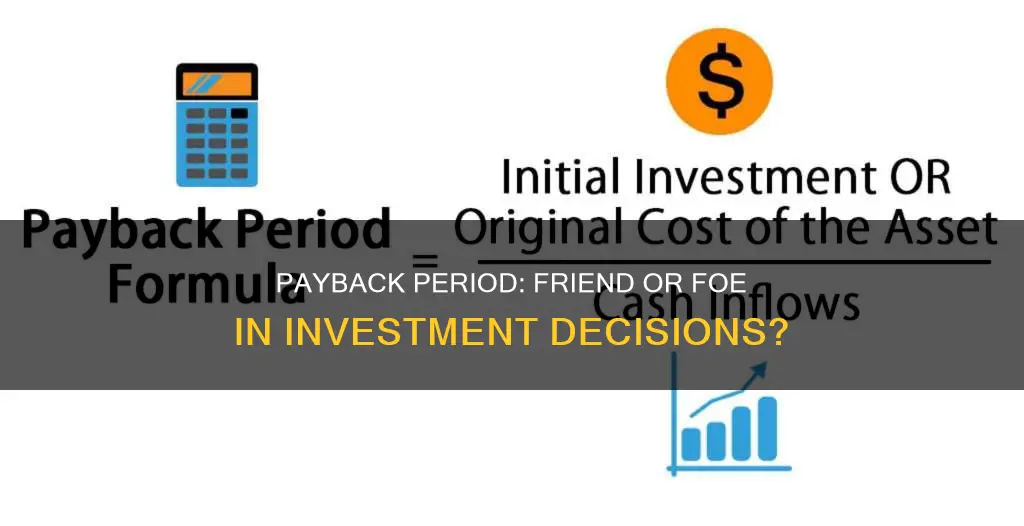
The payback period is a key metric used by businesses to evaluate investments and make decisions about which projects to pursue. It is the length of time it takes for an investment to generate enough cash flow to cover its initial cost. The payback period is based on cash flows, not accounting profits. It is a simple metric that can be easy to calculate and understand. However, it has its limitations and should be used in conjunction with other methods of investment analysis. When making an investment decision, it is important to consider the risk of the investment, the expected return, and the time frame of the investment.
| Characteristics | Values |
|---|---|
| Purpose | To determine how long it takes to recover the cost of an investment |
| Use | A method to calculate investment returns and make decisions about which projects to pursue |
| Formula | Payback Period = Investment/Annual Net Cash Flow |
| Timeframe | Expressed in years |
| Advantages | Simplicity, ease of calculation, useful for preliminary evaluation |
| Disadvantages | Ignores time value of money, risk, opportunity costs, long-term profitability |
What You'll Learn

Payback period as a screening tool
The payback period is a screening tool that can be used to identify potentially attractive investments. It is a simple and useful metric that shows how long it takes for an investment to break even or recover its costs. It is calculated by dividing the initial investment by the average annual cash flow. A shorter payback period is generally more attractive, as it indicates that the investment will generate a positive return more quickly. This also means that the investment is less risky, as the business can recoup its costs sooner.
The payback period is often used as an initial analysis or a "back of the envelope" calculation, as it is easy to calculate and understand. It is a useful tool for comparing different investment opportunities, especially when a quick decision is needed. However, it has some limitations and should be used in conjunction with other methods of investment analysis. One major drawback is that it does not show the return on investment, only the time it takes to break even. It also does not explicitly discount for risk and opportunity costs, and it does not take into account the time value of money.
Despite these limitations, the payback period is a valuable tool for investors and businesses when evaluating investments and deciding which projects to pursue. It can be particularly helpful for small businesses or those facing liquidity constraints, as it provides a simple way to compare the risk and potential return of different investments. By calculating the payback period, businesses can determine how long it will take to get their money back and decide if that timeframe is acceptable for their needs.
SEO Investment: When to Take the Plunge?
You may want to see also

Timing of cash flows
The timing of cash flows is a critical aspect of financial management, helping individuals and businesses assess their financial health, make informed decisions, and plan for the future. It can significantly impact the financial outcomes and the viability of investments or business operations. Here are some key considerations regarding the timing of cash flows:
- Time Value of Money: Receiving money sooner is more valuable due to its potential for investment. Future cash flows are subject to inflation and uncertainty. This concept is essential in cash flow analysis and investment decision-making.
- Discounted Cash Flow Analysis: This widely-used method considers the time value of money by discounting future cash flows to their present value. It helps evaluate the net present value (NPV) of an investment, providing a more accurate picture of its worth.
- Investment Decision-Making: Timing plays a crucial role in choosing between investment opportunities. Considering the time value of money, an option with a higher return over a longer period may yield a lower NPV than one with a lower return over a shorter period.
- Debt Service and Liquidity: Businesses must effectively manage cash flow to service debts and maintain liquidity. Timely cash flows are essential to meet financial obligations, such as paying interest, salaries, and suppliers.
- Revenue Recognition and Expenses: The timing of recognising revenues and expenses can impact a company's financial statements. Recognising revenue too early or postponing expense recognition can paint an inaccurate picture of profitability.
- Seasonal and Cyclical Variations: Many businesses experience fluctuations in cash flows due to seasonal or cyclical factors. Understanding these patterns is crucial for budgeting and working capital management to sustain operations during slower periods.
- Risk Mitigation: Diversifying investments across different time horizons can help spread risk. Having a mix of short-term and long-term returns can lead to a more stable cash flow and potentially better financial decisions.
- Weighted Average Life (WAL): WAL is a crucial concept in finance, especially for cash flow management. It considers the timing and amount of cash flows, providing insights into the expected return, risk, and duration of an investment or loan. It helps investors, lenders, and borrowers make informed decisions.
- Cash Flow Forecasting: Businesses can use historical data and market trends to forecast future cash inflows and outflows, enabling them to identify potential cash flow gaps and take proactive measures.
- Optimising Payment Terms: Negotiating favourable payment terms with suppliers and customers can significantly impact cash flow timing. Extending payment terms with suppliers can provide more time to generate revenue, while offering early payment incentives to customers can improve cash inflows.
In summary, the timing of cash flows is a critical factor in financial decision-making. By considering the time value of money, discounting future cash flows, and aligning revenues and expenses, individuals and businesses can make more effective choices, manage their cash flow, and achieve their financial goals.
Impact Investing: Social Enterprises
You may want to see also

Other factors to consider
When deciding whether to use payback period as a metric for investment decisions, it is important to consider its limitations and use it in conjunction with other methods of investment analysis. Here are some other factors to consider:
- Time Value of Money: The payback period does not consider the time value of money, which is the concept that money today is worth more than the same amount in the future due to its earning potential. This is a significant drawback as it can lead to inaccurate comparisons between investments. For example, an inflow return of $15,000 from an investment in five years is not the same as a $15,000 outflow today, as the purchasing power of $15,000 is likely to be lower in five years.
- Longevity of Investments: The payback period is a short-term metric and does not consider the long-term benefits or risks of an investment. It also does not take into account the lifespan of the investment. For instance, an investment with a shorter payback period may not be as attractive as one with a longer payback period if it has a shorter lifespan or becomes unprofitable after the payback period.
- Risk and Profitability: The payback period does not explicitly account for the risk and opportunity costs associated with the project. It also does not consider the overall profitability of the investment, as it only focuses on the initial investment cost and ignores cash flows after the payback period. This can lead to a preference for investments with shorter payback periods, which may not be the most profitable option.
- Complexity of Cash Flows: In reality, investments often involve additional cash outflows and fluctuating inflows over time. The payback period analysis assumes a one-time cost and steady cash inflows, which can be overly simplistic. It is important to consider the possibility of unexpected costs, upgrades, or fluctuations in revenue that may impact the actual payback period.
- Other Factors: When evaluating an investment, it is crucial to consider other factors such as the expected return on investment, the riskiness of the investment, the impact on cash flow, and any financing considerations. These factors can significantly influence the attractiveness of an investment and should not be overlooked.
Greece: An Uncertain Investment Climate
You may want to see also

Limitations of the payback period
The payback period is a popular method for evaluating investments due to its simplicity and ease of calculation. However, it has several limitations that investors should be aware of.
Firstly, the payback period fails to consider the time value of money. This means that it does not account for the fact that money today is worth more than the same amount in the future due to its earning potential. As a result, an inflow of cash in the future is viewed as having the same value as a cash outflow in the present, which is not an accurate reflection of its purchasing power.
Secondly, the payback period analysis only focuses on the initial investment and cash flows during the payback period, disregarding any inflows of cash that occur beyond this point. This makes it difficult to compare the overall profitability of different projects. For example, one project might have steadily increasing cash inflows for years after the payback period, while another might have declining cash inflows.
Thirdly, the payback period analysis does not account for the complexity of cash flows associated with capital investments. In reality, there may be additional cash outflows and fluctuations in inflows over time, which are not considered in this method.
Additionally, the payback period analysis does not take into account other important factors such as risk, financing, and other considerations specific to certain investments. It also does not factor in the profitability of an investment, which is crucial for businesses to assess.
Finally, the payback period does not consider the long-term benefits or risks of an investment and is, therefore, a short-term metric. This can lead to sub-optimal investment decisions, as projects with longer payback periods may be unfairly rejected, even if they offer higher returns or greater benefits in the long run.
Due to these limitations, the payback period is often used as a preliminary evaluation, supplemented by other methods such as net present value (NPV) analysis or the internal rate of return (IRR) for a more comprehensive understanding of an investment's potential.
Renewable Energy: Our Future's Investment
You may want to see also

Advantages of the payback period
The payback period is a popular method for evaluating capital expenditure projects because of its simplicity and ease of use. Here are some advantages of the payback period for investment decisions:
Simplicity and Ease of Use
The payback period is a straightforward concept that is easy to calculate and understand. It requires only a few inputs, such as the initial investment cost and annual cash flows, making it less complex than other capital budgeting methods. This simplicity enables quick decision-making, which is crucial for businesses with limited resources.
Preference for Liquidity
The payback period analysis favours projects that return money quickly, resulting in investments with higher short-term liquidity. This is particularly beneficial during times of economic uncertainty or when a business is entering a new market, as it reduces the risk of losses.
Useful for Small Investments and Small Businesses
The payback period is especially useful for small investments where more complex calculations considering discount rates and throughput impact are not necessary. It is a valuable tool for small businesses with limited funds, helping them carefully select projects with the quickest return on investment and maintain liquidity for future growth.
Risk Reduction
The payback period analysis focuses on how quickly an investment can be recouped, which is essentially a measure of risk. By comparing the relative risk of projects with varying payback periods, businesses can make more informed decisions. Projects with shorter payback periods are generally considered less risky, especially for small businesses with limited resources.
Reinvestment Opportunities
The payback period method allows businesses to identify investments that will pay back the fastest or most efficiently. This information is valuable for businesses aiming to continuously reinvest and grow, as it enables them to quickly recoup their investments and channel funds into new opportunities.
Green Buildings: Smart Investment, Healthy Future
You may want to see also
Frequently asked questions
The payback period is the length of time it takes for an investment to generate enough cash flow to cover its initial cost. It is usually expressed in years.
The payback period can be calculated by dividing the initial investment by the average or estimated annual cash flow.
The payback period is advantageous due to its simplicity and ease of calculation. It helps compare the risk associated with different projects by evaluating how quickly the investment can be recovered.
The payback period does not consider the time value of money, the effects of inflation, or the overall profitability of an investment. It also fails to account for the complexity of cash flows, including additional cash outflows and fluctuating inflows over time.
The payback period can be used as an initial screening tool to identify potentially attractive investments. However, it should be supplemented with other evaluations, such as net present value (NPV) analysis or the internal rate of return (IRR), to make more comprehensive investment decisions.







